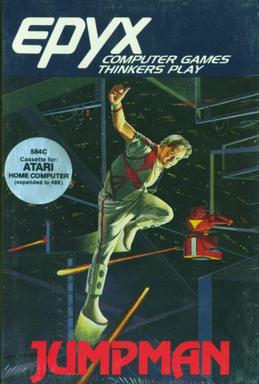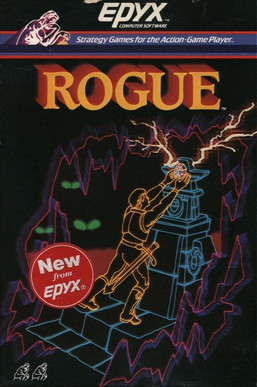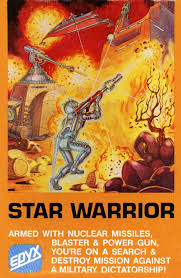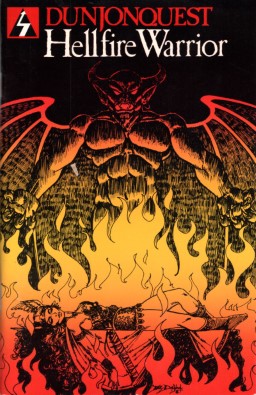
Jumpman is a platform game written by Randy Glover and published by Epyx in 1983. It was first developed for the Atari 8-bit family, and versions were also released for the Commodore 64, Apple II, and IBM PC.

Rogue is a dungeon crawling video game by Michael Toy and Glenn Wichman with later contributions by Ken Arnold. Rogue was originally developed around 1980 for Unix-based minicomputer systems as a freely distributed executable. It was later included in the Berkeley Software Distribution 4.2 operating system (4.2BSD). Commercial ports of the game for a range of personal computers were made by Toy, Wichman, and Jon Lane under the company A.I. Design and financially supported by the Epyx software publishers. Additional ports to modern systems have been made since by other parties using the game's now-open source code.

Pool of Radiance is a role-playing video game developed and published by Strategic Simulations, Inc (SSI) in 1988. It was the first adaptation of TSR's Advanced Dungeons & Dragons (AD&D) fantasy role-playing game for home computers, becoming the first episode in a four-part series of D&D computer adventure games. The other games in the "Gold Box" series used the game engine pioneered in Pool of Radiance, as did later D&D titles such as the Neverwinter Nights online game. Pool of Radiance takes place in the Forgotten Realms fantasy setting, with the action centered in and around the port city of Phlan.

Epyx, Inc. was a video game developer and publisher active in the late 1970s and 1980s. The company was founded as Automated Simulations by Jim Connelly and Jon Freeman, originally using Epyx as a brand name for action-oriented games before renaming the company to match in 1983. Epyx published a long series of games through the 1980s. The company is currently owned by Bridgestone Multimedia Group Global.

Sword of Fargoal is a dungeon exploration video game developed by Jeff McCord and published by Epyx for the VIC-20 in 1982. It was later published for the Commodore 64 in 1983. The game was originally released on cassette tape and 5¼" floppy disk formats.

Temple of Apshai is a dungeon crawl role-playing video game developed and published by Automated Simulations in 1979. Originating on the TRS-80 and Commodore PET, it was followed by several updated versions for other computers between 1980 and 1986.
Jon Freeman is a game designer and co-founder of software developer Automated Simulations, which was later renamed to Epyx and became a major company during the 8-bit era of home computing. He is married to game programmer Anne Westfall, and they work together as Free Fall Associates. Free Fall is best known for Archon: The Light and the Dark, one of the earliest titles from Electronic Arts.

Rescue at Rigel is a 1980 science fiction role-playing video game written and published by Automated Simulations. It is based on a modified version of their Temple of Apshai game engine, which was used for most of their releases in this era. The game was released for the Apple II, IBM PC, TRS-80, Commodore PET, VIC-20, and Atari 8-bit family.
A video game with nonlinear gameplay presents players with challenges that can be completed in a number of different sequences. Each player may take on only some of the challenges possible, and the same challenges may be played in a different order. Conversely, a video game with linear gameplay will confront a player with a fixed sequence of challenges: every player faces every challenge and has to overcome them in the same order.
An episodic video game is a video game of a shorter length that is commercially released as an installment to a continuous and larger series. Episodic games differ from conventional video games in that they often contain less content but are developed on a more frequent basis.

Gateway to Apshai is an action-adventure game for the Commodore 64, ColecoVision and Atari 8-bit family, developed by The Connelley Group and published by Epyx as a prequel to Temple of Apshai. It is a more action-oriented version of Temple of Apshai, with smoother and faster graphics, streamlined controls, fewer role-playing video game elements, and fewer room descriptions.

Star Warrior is a 1980 science fiction role-playing video game written and published by Automated Simulations for the Apple II, TRS-80, and Atari 8-bit family. The game is branded as part of the Starquest series, consisting of Star Warrior and the otherwise unrelated Rescue at Rigel.

Starfleet Orion is a 1978 science fiction strategy game written and published by Automated Simulations. It appears to be the first space-themed strategy game sold for microcomputer systems. The game was originally written in BASIC for the Commodore PET, but later ported to other early home computer platforms including the TRS-80 and Apple II. The game was something of a success, leading to a string of successes for the company, notably the major hit Temple of Apshai.

Hellfire, often called Diablo: Hellfire, is an expansion pack for the video game Diablo, developed by Synergistic Software, a Sierra division, and published by Sierra On-Line in 1997. Despite the objections of Blizzard Entertainment, the Hellfire expansion was produced, permitted by Davidson & Associates, their parent company at the time. Blizzard North, who was developing the sequel Diablo II, thus imposed numerous restrictions upon Synergistic Software's development of Hellfire.

Temple of Apshai Trilogy is a remake of three games from the Dunjonquest series, Temple of Apshai, Upper Reaches of Apshai, and Curse of Ra.

Dragonriders of Pern is a video game published by Epyx in 1983 based on Anne McCaffrey's book series of the same name. The game was released for the Atari 8-bit family and Commodore 64.

The Datestones of Ryn is a role-playing video game released in 1979 for the Apple II, Commodore PET, and TRS-80 by Automated Simulations. The Datestones of Ryn was the second title in the Dunjonquest series, but was actually a prequel to the first game, Temple of Apshai. Like its predecessor, this game was written in BASIC.

Morloc's Tower is a video game in the Dunjonquest series published by Automated Simulations in 1980.

Hellfire Warrior is a dungeon crawl video game for the Apple II, Commodore PET, and TRS-80 published by Automated Simulations in 1980. An Atari 8-bit family port was released in 1982. Hellfire Warrior is the direct sequel to 1979's Temple of Apshai.

Sorcerer of Siva is a 1981 video game published by Automated Simulations for the Apple II and TRS-80. The last standalone Dunjonquest game, Sorcerer of Siva is not as large as the major releases in the series, but also not as small as the MicroQuests.
















